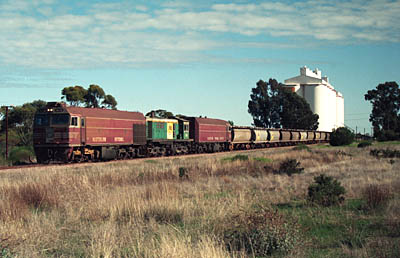

|
The narrow gauge Port Lincoln Division has always been isolated from the rest of the national rail network, and is one of only three ex-Government networks which share this distinction and are still operating today: the others are the short Normanton-Croydon line in Queensland and the present-day Tasrail. It is interesting to note that the total of 700 route kilometres of the Port Lincoln Division still open is double that of Tasmania.
The geography of the coastline of South Australia encouraged settlement in coastal areas, with a thriving ketch and coastal steamer trade developing. Port Lincoln is much closer to Adelaide by sea than by road; this, together with the deplorable state of many of the early roads, meant that the railway network on Eyre Peninsula focussed on Port Lincoln and Thevenard as seaports. From 1907 until 1960 the railway timetable was arranged around the sailing times of the regular Port Adelaide - Port Lincoln ships, in particular the MV Minnipa. This dependence on shipping gave rise to the practice on Eyre Peninsula of referring to Adelaide as being on the 'mainland'. |
|
|
The one traffic that provided the rationale for building the Port Lincoln lines was grain: the lines were constructed specifically to open up the inland areas of the Peninsula for agriculture. Prior to the coming of the railway it was not economical to grow wheat more than about 40 km from the coast. Grain haulage formed the primary traffic on the Division for most of its existence, and continues today with an average of somewhere around a million tonnes per year railed to Port Lincoln.
The other major commodity hauled is gypsum, from the Lake MacDonnell deposits near Penong to the port at Thevenard. Gypsum was hauled by rail in the 1920s, and then from the late 1940s to the present day. This traffic now regularly exceeds a million tonnes per year. |

|
|
In years past all manner of other traffics were handled. Passengers were catered for until 1968. Freight included the usual rural supplies, superphosphate, livestock and petroleum products. Salt was also hauled from Lake MacDonnell to Thevenard. In the years before water pipelines stretched across the Peninsula, water trains kept many settlers supplied. The railway also carried the pipes for construction of the pipeline network.
The Port Lincoln Division has always been an isolated 3' 6" gauge railway. The operational base is at Port Lincoln, where major workshop facilities are located. The 'main line' extended from there to the port at Thevenard (adjacent to Ceduna), with another major grain route branching at Cummins and running to Buckleboo. A short branch from Yeelanna went west to Mount Hope. At the western end of the division, a branch from Wandana to Penong was opened in 1924. Then in 1950, a short connection was built from Kowulka (near Penong) to Kevin, where vast gypsum deposits and salt workings are located. Traffic from Kevin increased to the extent that a new line was opened in 1966 from Penong Junction (near Ceduna) direct to Kevin. The original line from Wandana to Kowulka then closed, and the track at Kowulka was realigned so that Penong trains could run via Kevin. The Mount Hope branch was closed beyond Kapinnie in 1965. Since then, no lines have officially closed but services have been suspended indefinitely on several segments. The last trains ran between Kevin and Penong in March 1997, from Yeelanna to Kapinnie in October 2002, and beyond Kimba to Buckleboo in early 2005. The main line beyond Wudinna to Penong Junction (Ceduna) last saw trains in 2005, but is still used for occasional locomotive transfers between the depots at Port Lincoln and Thevenard. The South Australian Railways operated the Port Lincoln lines until 1 March 1978, when the SAR became part of the Australian National Railways (known simply as Australian National from 1980). Under AN stewardship the Port Lincoln Division was gradually re-equipped with locomotives and rolling stock from the former Commonwealth Railways' Central Australian and North Australian Railways. On 1 November 1997 the Eyre Peninsula lines (along with other intrastate lines in South Australia) were privatised and came under the control of Australia Southern Railroad. ASR was merged into the Australian Railroad Group in October 2002, then in mid-2006 (with the break-up and sale of ARG) the Eyre Peninsula lines became part of Genessee & Wyoming Australia. Photo above: NJ6, an 830 and NJ4 leaving Minnipa with an up grain train in the 1980s. Greg O'Brien. |
|
